This is a Kuribayashi Karoron folding medium format camera made by K.K. Kuribayashi Shashin Kikai Seisakusho in 1949. It shoots 16 exposures of 6cm x 4.5cm on a roll of 120 film. The Karoron is not a common camera outside of Japan, but it looks to be well built with some advanced features such as an automatic frame counter, Tessar 4 element f/3.5 lens, top plate shutter release, cold shoe, and 8 speed (plus Bulb) shutter. There were several variants of the Karoron made, one of which was a rangefinder model called the Petri, which is what Kuribayashi would eventually change their name to in 1962.
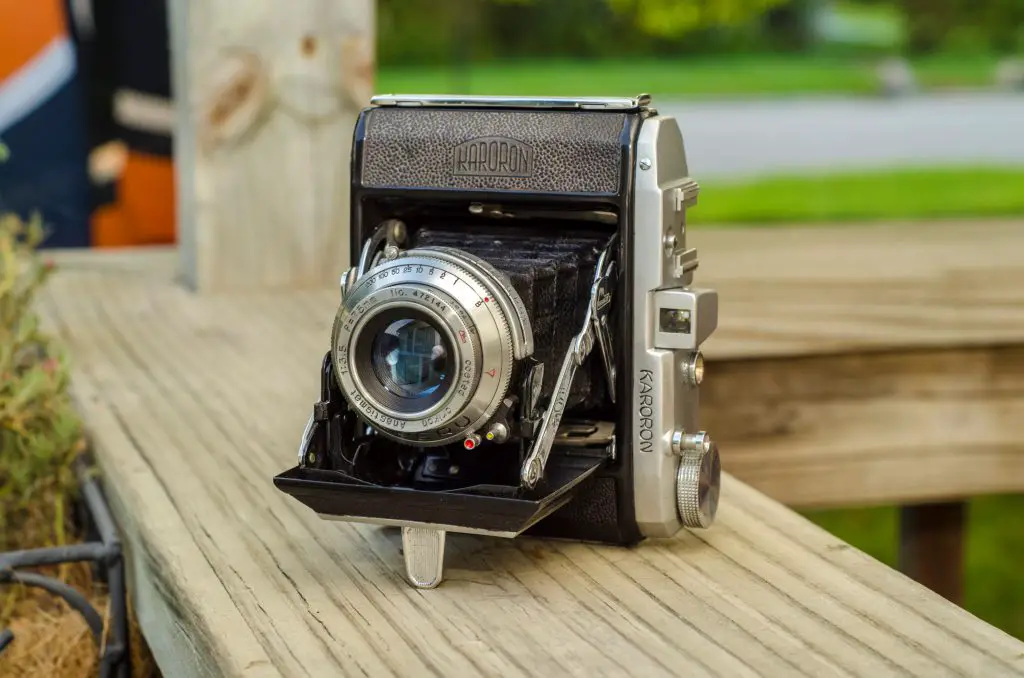 Film Type: 120 Roll Film (16 exposures 6cm x 4.5cm per roll)
Film Type: 120 Roll Film (16 exposures 6cm x 4.5cm per roll)
Lens: 75mm f/3.5 coated Orikon Anastigmat 4-elements
Focus: 3′ to Infinity
Type: Viewfinder
Shutter: Carperu Leaf (Looks to be a Compur clone)
Speeds: B, 1 – 1/200 seconds
Exposure Meter: None
Battery: None
Flash Mount: Cold Shoe
Manual: None
My Final WordHow these ratings work |
The Kuribayashi Karoron is a very nicely designed Japanese 6×4.5 folding camera. It was based off an excellent German design and uses well built shutters and lenses. The inclusion of a unique film counter is a very nice feature as it allows you to transport the film without having to keep looking at the frame numbers in the red window. Since it uses medium format film, the quality of images is much higher than that of a 35mm camera of the day, although it wont compare to top of the line roll film cameras of the day like the Kodak Medalist. Still, as a medium format camera with this combination of lens and shutter that fits in your pocket, it is one I plan on coming back to again. | ||||||
| Images | Handling | Features | Viewfinder | Feel & Beauty | History | Age | |
| 2 | 1 | 1 | 0 | 2 | 0 | 30% | |
| Bonus | +1 for inexplicable “cool” factor, I thoroughly enjoyed using this camera and the results that I got for it make me excited to use it again | ||||||
| Final Score | 8.8 | ||||||
History
I’ve been collecting cameras for a while now and even after all this time, occasionally I still hear about a company or model that I am not familiar with. If you search for the name Kuribayashi on Google, you’ll find a bunch of articles about General Tadamichi Kuribayashi of the Imperial Japanese Army. It would seem that General Kuribayashi was a pretty fascinating guy and held off the American army during World War II for quite a while. Clint Eastwood even made a movie about it.
It would make sense to name a Japanese company after a famous Japanese war hero, except that it wasn’t. It turns out that Kuribayashi, the camera company, was founded in 1907 when General Kuribayashi was only 16 years old.

The company, then known as Kuribayashi Seisakusho was founded in Tokyo by Kuribayashi Yōji and made a variety of photographic equipment like tripods and dark boxes. The company would eventually make it’s own camera in the 20s known as the Speed Graphic. It was a large format plate camera that could be custom ordered with a variety of lenses and shutters.
Many of Kuribayashi’s early products were sold by third parties under a variety of names. One of the more common names used was First Camera Works which was sold by a third party called Minagawa Shōten. For this reason, it can be incredibly difficult to identify a Kuribayashi made product.
In the 1930s, Kuribayashi made many folding roll film cameras such as the Semi First and First Six. These cameras were very similar to designs by German companies such as Balda and Welta.
During World War II, at least one of Kuribayashi’s offices in Tokyo was destroyed. There isn’t much information about what the company was doing around this time. It wouldn’t be until 1949 when Kuribayashi would regroup and change names to K.K. Kuribayashi Shashin Kikai Seisakusho and move to Chiyodo, Toyko. At this time, the company also ended it’s ties with Minagawa Shōten and would cease selling products under the First Camera Works name. Kuribayashi would release two new lines of cameras, one called Karoron which would be a lower end line of folding cameras, and a TLR called the Petriflex.
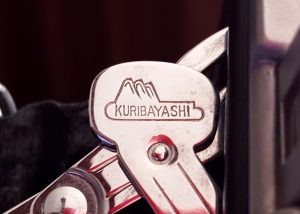 Like many other Japanese camera makers, Kuribayashi would see quite a bit of success in the 1950s. They would release their first 35mm rangefinder in 1954 and their first 35mm SLR in 1959. As was customary at this time, in 1962 Kuribayashi would change it’s name to that of it’s most successful camera and became known as Petri Camera K.K., or simply, Petri.
Like many other Japanese camera makers, Kuribayashi would see quite a bit of success in the 1950s. They would release their first 35mm rangefinder in 1954 and their first 35mm SLR in 1959. As was customary at this time, in 1962 Kuribayashi would change it’s name to that of it’s most successful camera and became known as Petri Camera K.K., or simply, Petri.
Petri’s cameras were generally highly regarded and well built designs. They saw moderate success in export sales throughout the 50s and into the 60s, but like Miranda, who was another Japanese camera maker, they had a difficult time transitioning into the electronic age and mass producing their products. As a result, Petri was heavily outsold by it’s competition from Nikon, Canon, Minolta, and Pentax in the 1970s. The company would limp through the decade, selling it’s products under a variety of other nameplates before finally going into bankruptcy in 1977. The Petri name would be revived a couple of times in the coming decades making a variety of products such as telescopes, but it would not be the same company.
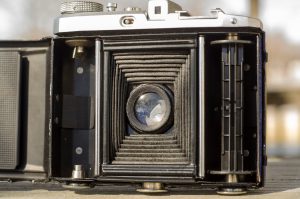
Today, there is limited demand for Petri cameras, even less so for Kuribayashi named products. As I mentioned early in this article, I had never even heard of the Karoron prior to finding this one. It’s biggest saving grace is that the camera appears to be well built and has a good looking lens. I am intrigued by the fact that it takes 6cm x 4.5cm exposures, getting me 16 photographs on a single roll of 120 film.
There is very little information about my camera, and hopefully after posting this review, it can function as a resource for other people who might come across a similar model.
Repairs
Using my experience disassembling similar folding cameras such as the Welta Watson and AGFA/ANSCO B2 Commander, I started to disassemble the lens in an effort to clean the shutter.
Like most folding cameras, the outer lens element has a couple of set screws that need to be loosened which then allow you to unscrew the front element. I didn’t realize it at first, but the post on the side of the lens that stops you at maximum and minimum focus needs to be completely unscrewed, or else you wont be able to turn the element more than one full rotation.
If you were doing this yourself, I would recommend you pay special attention to how many turns of the lens were needed to remove it, but I intended on collimating this lens, so I didn’t bother to keep track. For the record, it was somewhere around 7 full turns.
After I got the outer element off, I gave it a good cleaning and was pleased that it was in good condition with no fungus or internal haze.
The shutter however, was coated in oil. This camera had more oil in it than any other camera I’ve ever worked on. I am not kidding, it was literally coated in the stuff. I suspect that someone before me attempted to clean and lube this camera and went crazy with oil. I do not see how this camera could have made it out of the factory with this much oil.
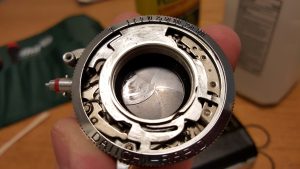
Behind the front lens is a metal plate held in by two screws that expose the internal workings of the shutter. This plate also is the speed selector, so as soon as I removed it, the camera could no longer be properly cocked and fired, but that was OK.
I was afraid to go any deeper into the shutter as I did not have any accurate information about this particular shutter, but at this point I doused the entire shutter in Ronsonol lighter fluid. I did this over the course of 3 days, doing it 2-3 times each day, and trying to dry up as much as possible off the leaf blades with Q-tips.
Although it’s probably not a good idea to let the bellows get wet, there was no way around it without completely removing the shutter, which I was not prepared to do. I tried my best to apply the lighter fluid in a way that would not soak the bellows too much, although some parts of it did get wet. In theory, Ronsonol shouldn’t hurt bellows, but it is definitely something you would want to avoid if possible. Since I had very little in this camera, I felt it was worth the risk.
Edit 2/24/2016: In hindsight, removing the shutter from the camera is relatively easy and would have made the cleaning process a lot simpler. See my review for the AGFA /ANSCO B2 Commander for how you would remove a shutter from a folding camera such as this.
Over the course of the next several days, I would bathe the shutter, wipe it down, let it air dry, and repeat.
Eventually, I got the shutter to a point where I felt it was satisfactorily clean. I wiped off the inner aperture blades and inner lens element (by holding the shutter open in Bulb mode) and put everything back together.
To my delight, the camera not only survived my cleaning, but it appeared to work in every speed. Even 1 second was pretty accurate!
The viewfinder was a tad dirty, so I removed the two screws on either side of it, and cleaned inside of the viewfinder with rubbing alcohol and a Q-tip and put it back together.
While the whole process did take me several days to complete, most of that time was spent waiting for each cycle of the Ronsonol to dry. In total, I probably spent an hour working on this camera.
With everything back together, I loaded in a roll of Ilford FP4 black and white film and went shooting.
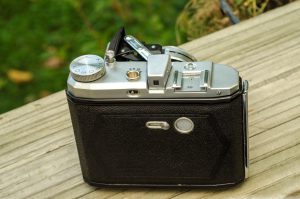
My Thoughts
The Kuribayashi Karoron is a pretty cool little camera that unfortunately fell victim to the large amount of Japanese makers and models which exploded onto the market after the conclusion of World War II. Was there something inherently wrong with the design or the function of this camera? No. It just got lost in the mix of all of the other competing models at the time.
I think that the mentality of the rest of the world in the late 1940s was not to trust anything exported from Japan. After all, they were the “bad” guys. It would take a decade or so for these Japanese companies to build up a reputation for quality and precision that would open the minds of the rest of the world.
Although Kuribayashi would have some success after changing their name to Petri in the early 60s, they are still a relatively unknown marque to most people. When you think of Japanese camera companies, Nikon, Canon, Konica, Minolta, Olympus, Yashica, Asahi Pentax, Fujinon, and Mamiya all come to mind first. Even among the lesser known companies, Miranda (Orion), Kowa, Ricoh, and Topcon all probably rank higher than Petri did.
Still, this camera is really quite nice. The 4-element Orikon lens had a maximum aperture of f/3,5 which meant it should be reasonably bright for a medium format lens, plus it was coated. I assume it is a Tessar based design since most 4-element lenses of the time were. The shutter appears to be some clone of a Compur shutter which was a very good shutter. Finally, it took 6cm x 4.5cm shots on 120 film which meant you could get 16 exposures per roll instead of 12 like on a 6×6 camera. I was intrigued with this camera and excited to use it.
When I received it, it was in mostly good condition, but I could see that immediately it would need some work. It wasn’t as obviously broken as the Ciro Flex, but I could see that the shutter was sticky and there was oil on the blades. The bellows and the lenses looked good, and the body was in mostly good condition. There is a small piece of leatherette missing from the door catch on the side.

On the right side of the view finder is a stamped “EP” logo, which research tells me is a “Post Exchange” mark that was placed on Japanese products exported out by US Army and Naval officers. The Post Exchange mark was operated by the Army & Air Force Exchange Service in the late 40s and 50s. There is a thread on Photo.Net which claims that the EP program existed as late as the early 1970s but I cannot confirm that.
Supposedly, items sold with this mark were not subject the same taxes as non stamped items. It was a way for American servicemen to buy Japanese products and take them home without paying the same taxes as things sold on the domestic market. This probably means that my Karoron was once owned by an officer or solder in the US Army or Navy.
Using the Camera
Every 35mm folding camera I own has a spring loaded door with a self erecting lens. Due to the scarcity of information about the Karoron, I am not sure if that’s how this is supposed to be, because mine don’t open by itself. Pressing the door release button on the top of the camera doesn’t do anything other than unlock it. You need to pull/pry the door open with your fingers to get it to open. There is absolutely no tension that would ‘pop’ the door open.
While opening the door, the lens/shutter assembly doesn’t come out on it’s own either. If you attempt to pull the door open all the way without first pulling out the lens/shutter assembly, it will jam. I learned this the hard way, but thankfully, I didn’t break anything.

I really feel the Karoron is a well designed camera, so I have to believe that this isn’t how it is supposed to work. My guess is, that there should be some type of spring that helps slide out the lens and shutter and open the door all in one motion. Earlier, I mentioned that I had suspicions that someone previously tried to repair this camera, so it’s entirely possible that they lost a spring or something. In either case, it’s not difficult to do, it’s just something that you have to remember to do, otherwise the door wont fully open and the lens and shutter will not properly move into position. Since it is highly likely that this is unique to my specimen, that is the last I will say about it.
Once the camera is fully open, you see the typical array of features for a folding camera. Like the B2 Commander and Kodak Retina, the Karoron has a top plate shutter release button that is connected via a folding linkage. I know that on many cameras such as the Retina, this linkage can bend or become damaged if not used properly. Thankfully that’s not the case with this one. I am able to fire the shutter using the top shutter release without any issue.
One curious design element is the aperture selector which resides underneath a metal plate with aperture numbers printed on it. This metal plate has a narrow slit in it where you can see the selected aperture. There is no easy way to move this pin other than shove your fingernail in there to move it. The design of this seems rather awkward, but I also don’t see any other way to do it. I cannot find any manual for this camera online and the one and only other post (with pictures) online, looks exactly like mine. I have to guess that this was how it was designed, even though it is strange.
Shutter speeds are selected by rotating a knurled ring around the shutter, and on the top part of the shutter is the cocking lever.
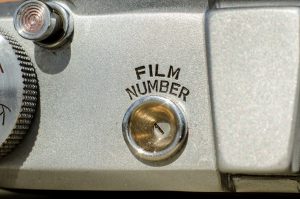
The Karoron has no double exposure protection, so you have to remember to advance the film after each exposure, or else double-expose your image. There is a rather nice exposure counter on the top plate of the camera, however this counter does not have any stops, so you must pay attention to the number and stop at the next number, otherwise you will go past the next frame, wasting film. The biggest benefit to this frame counter is that you do not need to keep looking at the red window when advancing film. The less often you have to open the door to the red window, the less likely for light leaks.
Through my research, I found that there was a more basic version of the Karoron called the Karoron S which is lacking this exposure counter. It may or may not have the top shutter release as well, but I am not sure. In any case, the presence of the “S” model means this was not designed as an entry level camera. I applaud Kuribayashi’s attempt at putting an uncommon feature like an exposure counter which saves you from having to use the red window.
Loading film into the Karoron is uneventful. Open the door and load 120 film like you would any other roll film camera. There is a little lever on the back plate of the camera, to the left of the viewfinder which resets the exposure counter, so when loading film, you must first advance the film so that the number ‘1’ appears in the red window on the back of the camera, and then reset the exposure counter. Once you’ve reset the exposure counter to ‘1’, you do not need to open the red window for the remainder of that roll.
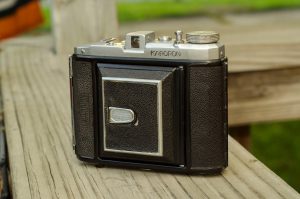
This being a 6cm x 4.5cm camera, the viewfinder is shaped like a rectangle. When holding the camera in a typical orientation (the front door to the left), your images will be in a “Portrait” orientation. If you want to take Landscape photos, you must turn the camera 90 degrees so that the front door is facing down (or up, but that would be awkward).
I’d say the most unusual aspect of using this camera is that it is left-handed. The shutter release and winding knob are both on the left side of the camera. The button that looks like a shutter release on the right side is the door catch release. This makes the Karoron my second ‘southpaw’ camera along with the Ihagee Exakta.
With the left shutter release, exposure counter, and difficult to move aperture selector, shooting with this camera is a unique experience. There’s just enough difference between this an other folding cameras to make it a challenge, yet nothing is so difficult that it takes away the fun factor of the camera.
My Results
Using the Karoron was quite pleasant despite the left handed controls. Unlike the Exakta which is another left handed camera, the Karoron is easy to hold, lightweight and requires little effort to use. Since the “normal” orientation of the camera produces portrait style shots, I found that for at least half of the first roll, I turned the camera 90 degrees to get landscape shots like you would in the normal orientation of a full frame 35mm camera.
My first roll was shot with Ilford FP4 and the results were very uninspiring. Many of the images had a soft focus and seemed to have major exposure issues. The odd thing though, is that almost all of the images looked both over and underexposed at the same time. The more I look at the scans I received back, I started to think that the issue was with the scanning. I don’t have my own scanner or anyway of really magnifying the negatives, so I couldn’t be sure. I posted the images above in a camera collector’s group and the general consensus was that the images were underexposed and over developed. Despite these discouraging results, I was still confident that the camera was working properly and that the focus was correct, so I took another chance and this time used a fresh roll of Kodak Portra 160 color film.
I shot all of these images during the same Chicago trip as when I shot with 5 other cameras, and I can honestly say the Karoron gave me the most consistently excellent shots. It helped that I used fresh film in this camera compared to some of the others in which I had expired film. The Portra might be designed for portraiture, but it does a heck of a job with city landscapes as well.
I kept the shutter at 1/100 and 1/200 the entire day and my aperture between f/8 and f/11 for all of these which coincides with Sunny 16 for Portra and I feel that the exposures are pretty spot on, which tells me the shutter is at least close to accurate. The shutter is a Compur clone, so I can say that Kuribayashi did a marvelous job at copying the original German design. I really wish I had taken more pictures of the shutter while I was cleaning it because to this day, this was the oiliest shutter I have ever taken apart. It was in terrible shape, which is all the more reason to celebrate these images.
The lens is sharp and renders colors well across the image. This should be no surprise considering the glowing blue coating on the front of the lens. I see no significant difference in sharpness at the corners compared to the center of the image, however I do see a bit of vignetting around the corners on many of the images. It would appear that the Orikon lens struggles with even coverage near it’s edges, but hey, at least it’s sharp!
The Kuribayashi Karoron was at the dawn of Japan’s dominance making cameras and technology after WWII, and results like this really prove that the optics industry back then was already very healthy. I now have 3 Japanese 6×4.5 folding cameras and I think this one is my favorite. Perhaps it’s because it was my first, perhaps it’s that beautiful blue coating on the lens element, or maybe it’s just the overall design of the camera.
Additional Resources
http://camera-wiki.org/wiki/Karoron
http://www52.atwiki.jp/petri/pages/194.html
http://photo.net/classic-cameras-forum/00ZHqt
http://minorhouse.cocolog-nifty.com/blog/2007/09/post_3f7e.html
https://www.flickr.com/photos/heritagefutures/albums/72157633140291410


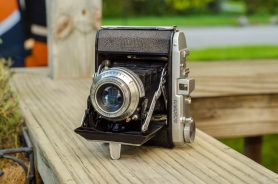













Excellent article! Thank you! I have one too and have used it and like it a lot. You are right about the lens/door. Mine aligns nicely as you pull the door open. It doesn’t pop open though, as you noted. Look for a very thin serrated disc on the bottom of the lens, running along the back of the shutter. It is used for setting the aperture! mine is quite stiff to move.
Hi Mike:
Not sure if you’re still shooting with this camera, but if you are, you’ll be happy to know that there is a control for setting the aperture, though it’s easy to miss. At the base of the shutter assembly, on the bottom, there is a toothed dial (like the one for the shutter speed). Turn that with your index finger to set the aperture–no need to poke at the indicator. (Hope that makes sense. If not PM me and I’ll send a picture.)
Gary.
Gary, you are right! I just took a look at the camera and I see it now! I haven’t touched this camera in quite a while, but I think this deserves and update to my review and a fresh roll of film! Thanks!
Another really informative review on a folding Japanese camera. Looks like I may have to track one of these down! Thanks for posting, kind regards, Phil
Kuribayashi is well-known to IR photography fans, because certain of their early-1960s Orikkor lenses, made for Petri 35mm SLRs, transmit more near-IR wavelength light than most other lenses do. As such, this vintage Orikkor glass commands high prices on The Bay, from folks shooting digital with modified cameras with IR-pass filters on their sensors.